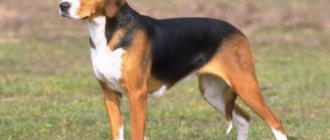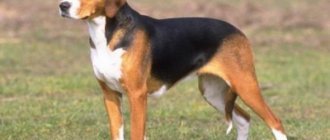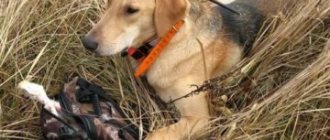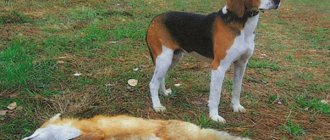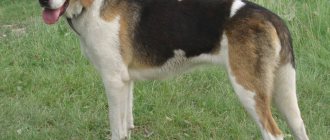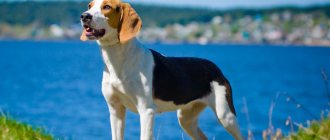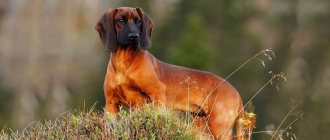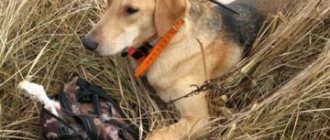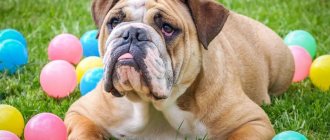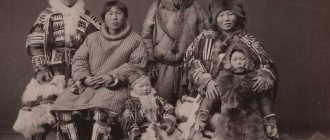For hunting, you will definitely need a like-minded person who will not let you down at a crucial moment, but will clearly complete the task assigned to him. The Russian Hound is considered the best for mating. After all, passion, the instinct to pursue prey is in the blood of a hound. A loud and melodious bark distinguishes representatives of this breed from other four-legged animals.
| Source | Russia |
| Usage | Hunting dogs |
| Color | Black back, cunning and tanned |
| Dimensions (edit | Height at withers 54 - 69 cm. Weight 24 - 29 kg. |
| Duration | 9-12 years old. |
History of the Russian Piebald Hound breed
In Russia at the beginning of the 19th century, everyone who was not too lazy was engaged in breeding hounds, which ultimately led to the loss of a single breed type by the animals.
Every landowner capable of maintaining a kennel considered it his direct duty to play at being a breeder. As a result: the dogs spontaneously acquired the blood of harlequins, as well as Polish and big-breasted hounds, which affected not only the appearance, but also the working qualities of the offspring. In particular, by the middle of the 19th century, Russian hounds had lost their natural viciousness and became unsuitable for wolf hunting. They decided to correct the situation by crossing domestic stock with foxhounds. The latter at that time were considered standard hunters and already had a stable phenotype, which Russian hounds so lacked. As a result of the mating of the two breeds, elegantly colored and hardy dogs were born, which inherited aggressiveness towards animals from the English parent, and outstanding rutting abilities and a ringing, melodious bark from the Russian parent.
At first, experiments to breed a universal hunting dog were unsystematic and were not always successful. In addition, some owners, in addition to English hounds, used French producers for mating. Nevertheless, by the 30s of the 19th century, a group of leaders emerged among the breeders, whose flocks were considered the most successful in exterior and working terms. In particular, among professional hunters, individuals from the kennels of S. M. Glebov, P. A. Bereznikov and I. L. Kramarenko were extremely popular.
At the beginning of the 20th century, the descendants of Foxhounds and Russian hounds began to be purposefully bred. By that time, the breed had managed to make a name for itself at exhibitions and acquire its own name. Now its representatives were called Anglo-Russian hounds - in memory of their British roots. Unfortunately, after the collapse of the Russian Empire, animals were on the verge of extinction. As an example: at the 1923 exhibition, only eight individuals were exhibited, and even those were very different from each other in external indicators.
The Anglo-Russian hound received its first official standard at the All-Union Cynological Congress in 1925, which sharply increased its value in the eyes of ordinary people and amateur hunters. Thus, before the Great Patriotic War, there were already about six elite hound lines in the USSR, the representatives of which became the ancestors of all today’s individuals. As for changing the name of the breed from Anglo-Russian to Russian piebald hound, this procedure was carried out in 1947 (according to another version - in 1951).
Mating
To find a suitable party, they turn to dog clubs. It is unacceptable to look for an advertising partner on the Internet or through friends. Only in the club can you get reliable information about the health and pedigree of the “groom” or “bride”.
The mating partner must be “vocal”, that is, have a melodic, persistent and melodic bark, characteristic only of the Russian Hound breed.
The optimal age of a bitch for mating and offspring is from one and a half to six years. Right now the dogs are in full bloom. Previous or later matings can lead to premature birth or weakened offspring.
During mating, the bitch must be treated for fleas and worms. It's best to double-check that you have all the required vaccinations. Only in this case will the mother be able to provide her puppies with her immunity during the first 8 weeks of the babies’ lives. Mating occurs in the morning; the animals are not fed. Let him walk a lot. The bitch enters the dog's territory. They have time to get to know each other. If the dog is mating for the first time, then perhaps human help is needed. The dogs are placed side by side, and the dog is helped to put its paws on its back. Control matings are carried out in a day or two.
Appearance of the Russian Pinto Hound and its differences from the Russian Hound
Despite the close family connection between the piebald hound and the Russian hound, the breeds are not complete copies of each other, although it can be difficult to immediately determine whether an animal belongs to one or another clan. Typically, the Russian piebald hound is identified by its bright spotted coat with a characteristic blush. In addition, representatives of this family are “dressed” poorer than their fellow tribesmen. There are small differences between the breeds in the shape of the ear flaps, as well as in movements (the Russian Hound's stride is noticeably lighter). At the same time, the height of both the Russian hound and the piebald hound is almost the same. Males reach 58-68 cm at the withers, females - 58-64 cm. The Russian Piebald Hound should weigh from 25 to 35 kg.
Head
The dog's head is of a dry type, with an oblong, voluminous, but not overly wide skull. The eyebrows and occipital protuberance are barely noticeable; the transition from the head to the muzzle forms an expressive but gentle ledge. The muzzle profile of the Russian Pinto Hound has a classic rectangular shape.
Teeth and bite
Massive, even, frequently spaced teeth fit together into standard “scissors.”
Nose
With a flat back and a voluminous convex black lobe.
Eyes
The eyes of the Russian pinto hound are medium-sized, oval or slightly oblique, with a dark edge of the eyelid. The iris of breed individuals varies from hazel to dark brown tones.
Ears
The triangular, slightly rounded at the tip of the dog's ear is located above eye level and is always in a hanging position. Sometimes the skin on the ear may bunch up, but this is not a requirement.
Neck
The Russian Pinto Hound's neck has a pleasantly rounded contour and is moderately muscular.
Frame
Russian piebald hounds are dogs of relatively strong constitution, with a massive chest dropped almost to the elbows, a wide back, a convex loin and a solid sloping croup. The belly of representatives of this breed is tucked above chest level.
Limbs
The legs of the Russian pinto hound can be described as bony, dry, but at the same time distinctly muscular. The angle of the dog's shoulder joints is approximately 100°, while the angle formed by the hock joints can reach 130-140°. The pasterns and metatarsals of the animal are almost vertical. As for the paws, RPGs can have them oval or slightly rounded with arched toes gathered into a ball.
Tail
The dog's saber-shaped tail, thickened at the base and tapering towards the tip, is perkily raised upward. The standard tail length is to the hock joint or 2-3 cm shorter.
Leather
Elastic, but dense, without forming jowls or wrinkles.
Wool
The coat of the Russian piebald hound is of a double type with abundant undercoat. Usually the dog is short on the head, ears and legs, and longer on other parts of the body (about 4-5 cm). The most abundant and longest hair is on the back of the neck and the outer side of the thighs.
Color
The most common color of the breed is black and piebald with blush. The size of black spots is not limited by the standard, even if they flow into a clear saddle cloth. The tan (rouge) is always located on the head, rump and shoulders, while the dog's legs and belly remain white. Purple piebald with slight speckling and gray piebald with blush are also considered acceptable color types.
Possible defects
- Head and neck in folds of skin.
- Thick speckled coat color.
- Lack of blush, blue and brown spots on the dog.
- Snub-nosed or hunchbacked muzzle with a steep stop.
- Ears raised, curled into a tube and decorated with long hair.
- Green, blue eye color; heterochromia.
- Tail with pendulous or tipped to one side.
- Clubfoot or short-legged; Kozinets.
- Wool with waves or without undercoat.
- Brown, spotted or flesh-colored lobe.
Breed standard
A hunting hound with strong bones, proportional build, and well-developed muscles. It has incredible endurance and can track prey for a long time. The exterior is designed according to its natural purpose: hunting. In the description of the breed it is worth adding such a characteristic feature as “singing bark”.
Signs that determine the breed standard:
- The head is trapezoidal in shape and medium in size.
- The skull is round in shape, with strong bones, smoothly turning into a wedge-shaped muzzle.
- The triangular ears are set high on the head and droop gently. Slightly rounded at the ends.
- The eyes are round, not protruding. The eyelids have a dark border.
- The lips are not drooping, tightly fitting.
- The teeth are white, strong, rather large.
- The nose is large, with rich black pigmentation.
- Flat cheekbones that do not stand out from the overall contour of the muzzle.
- Muscular and dry neck, smoothly turning into the withers.
- The back is strong, straight, slightly arched at the croup.
- Saber-tooth tail raised.
- Limbs are strong and straight. The front and back are parallel to each other.
- Short hair on the head, legs and ears. Slightly longer at the back. Cover the tail with thicker hair at the base; hair length is short to the tip. The undercoat is thick, dense and well developed.
- Main color: black and tan. The Russian Pied Hound standard allows for the presence of a black support leg. The lower body and limbs are white.
- The dog's movements when searching for prey are a free trot, a slow gallop. In pursuit of loot, switch to the map.
Description of deficiencies in the presence of which the dog is subject to rejection:
- Camel sagging or return.
- Lack of pigmentation.
- Nose with partial or complete absence of pigment.
- Low ears.
- Narrow underdeveloped chest.
- Upturned muzzle.
- Long curly coat, no or weak undercoat.
- Crooked front and/or hind limbs.
- Excessive aggression or cowardice.
Character of the Russian pinto hound
When not hunting, the Russian Piebald Hound is a calm, sometimes slightly lazy creature that does not create any special problems, but you will have to get used to its antics. In their free time from chasing forest dwellers, RPGs prefer to save up energy for the next forced march, so they are not particularly active at home. In relations with the owner and members of his family, Russian piebald hounds are friendly and well-balanced good boys. More precisely, almost good boys, because the well-bred behavior of an animal is often a cunning game for show, in order to reduce the owner’s vigilance.
In general, representatives of this family make mediocre companions and pets. The breed likes to show maximum independence in all matters and is not eager to toe the line. For example, instead of begging for forbidden food, the dog will prefer to steal it from the table, and will not hesitate to do this trick in front of the owner. It will not be possible to make friends with the Anglo-Russian hound with small pets such as cats, toy dogs and guinea pigs. Like any four-legged hunter, the piebald hound sees the miniature fluffies as nothing more than easy prey that needs to be caught as quickly as possible.
Russian piebald hounds are natural leaders and hunters, but territorial instincts and suspicion are completely alien to them. If you hope that in addition to producing trophies, your pet will also carry out security activities, then it is completely in vain. Russian piebald hounds do not experience negative emotions towards strangers and the maximum they can do when a stranger appears on the doorstep is to bark loudly and kindly.
Basic moments
- Russian piebald hounds are quite talkative, but they do not always use their voice for its intended purpose, so you will have to get used to the pet’s periodic idle talk.
- The breed is not recognized by the FCI and is not widely represented abroad.
- If we do not take into account the individual characteristics of each dog, then in general the RPGs are distinguished by greater viscosity and anger towards the beast than their relatives - Russian hounds.
- This is not the most manageable breed, especially outside of hunting, so taking a hound puppy with the goal of molding him into a companion or an obedient city dweller is a pointless exercise.
- The Russian piebald hound is not a pet for an apartment, especially if it is inhabited by small animals like cats, chinchillas and other objects of canine interest.
- Despite their generally non-conflict nature, the desire for leadership and independence is not alien to representatives of the breed. For this reason, dogs are not recommended for purchase by inexperienced owners who have a vague understanding of the principles of training and training hounds.
- Adults are distinguished by phenomenal endurance, so intense physical activity can only benefit them. In addition, instead of the standard two-time walk, Anglo-Russian hounds are given three hour-long walks every day.
- Following the trail left by the animal, the dogs “turn off” their hearing and do not respond to the call for a long time. On the one hand, this behavior is considered to be the key to the fun and profitability of hunting, and on the other hand, it is the main reason why animals get lost in the forest and cannot get out of the thicket on their own.
The Russian piebald hound is an ambitious and passionate fan of gun hunting, who knows how to turn a trip to nature into an exciting quest. Possessing a stable psyche and a relatively calm temperament, this persistent, smart girl quickly finds contact with the owner, provided that he is not lazy to set aside time for daily jogging and excursions in her company. However, you shouldn’t delude yourself too much about a dog’s feelings for a person. Work has always been and will remain in the first place for the Russian pinto hound. Accordingly, you can earn the love of an animal only by being imbued with the hunting craft as much as the dog itself is imbued with it.
Education and training
It is customary to talk about Russian piebald hounds as dogs with intelligence and remarkable memory, quickly solving educational problems. However, the high mental abilities of the breed do not guarantee unquestioning obedience and attentiveness of its representatives. Moreover, the natural independence of the hound and its desire to be a leader wherever possible can mix up all the cards for the owner. Don’t delay socialization and training and adopt the puppy as soon as he crosses the threshold of the house - then it will be too late.
Teenage stubbornness and the child’s attempts to assert himself will have to be taken for granted. Russian piebald hounds were born with these qualities and will not give them up easily, so during training, always leave the last word for yourself and never make concessions unless you want to change places with the dog. However, do not forget that in training a Russian pinto hound there should be no place for physical punishment and shouting. Replace these ineffective anti-stimuli with treats and affection, but very sparingly. An RPG should not work just to earn a delicacy.
It is better to start training Russian pinto hound commands when the dog is 4-5 months old. The training program begins with practicing the order “Sit!” As soon as the pet gets used to fulfilling this requirement, you can move on to the next stage - the commands “Lie down!” and “Nearby!” In addition, the age of 5-6 months is the optimal time to accustom the Russian pinto hound to swimming and walking in a muzzle. Do not forget, without the latter, the appearance of a hunting dog in crowded places is prohibited.
Socialization
From the age of three months you can start raising a puppy. It is very important to instill qualities such as courage. Communication with peers is very important: sitting alone, the puppy will never learn to defend itself.
Basic training will help you get used to other people. Special training programs, especially for hunting dogs, will lay the foundation of hunting skills: not to be afraid of barking, loud sounds of a shot and a hunting horn, in order to be able to catch game correctly.
If there is a small child in the family, you need to carefully monitor how he communicates with his four-legged friend. A puppy, feeling threatened by a small person, may bark and even bite in order to defend itself. A puppy who grows up with a child will be more loyal to him.
Hunting with a Russian pinto hound
The purpose of breeding the breed was to obtain a viscous (persistent in pursuit), vicious to the beast dog, with which it would be possible to go not only to the hare and fox, but also to the wolf. As a result, Russian piebald hounds turned out to be more vocal and heavy in movement than their relatives - Russian hounds, but with a less wide crawl (search). The bright color of the breed can be considered an additional bonus: a dog lingering in dense growth can be seen from afar, which is already valuable. In addition, in the process of pursuing a spotted pet, it is impossible to confuse it with a wild animal, such as a fox.
The hunting talents of Russian piebald hounds are inherited, so if the puppy’s ancestors did not distinguish themselves in any way, it is useless to demand outstanding achievements from their descendant. One should not lose sight of the fact that the breed’s pursuit instincts are not so strong that its representatives can work without training. Accordingly, if you want to see a provider in your pet, get ready to work hard.
Important: Russian piebald hounds have developed the so-called bestiality. This means that the dog mistakes large domestic animals and birds for animals and practices hunting techniques on them. Under no circumstances should such attacks be allowed, so if you notice that your pet is catching a sheep or rushing at chickens, punish it - immobilize the dog and “beat” it with the same sheep.
They begin to introduce the Russian piebald hound to hunting from the ground. In autumn or spring, when the ground is free of snow, the puppy is taken out into the forest, giving him the opportunity to run and pick up an animal's trail. Walks should be intense, but not exhausting and not every day, so that the dog does not lose interest in work, and it is not recommended to let the animal follow a fresh trail. Of course, it is much easier to find a fox that has just walked under its nose, but in the future, a dog accustomed to easy tasks is unlikely to show persistence if it comes across a rather cold trail.
An interesting fact: having discovered prey, Anglo-Russian hounds communicate this to the hunter by voice. Moreover, it is very easy to guess which animal the dog was tracking: the barking of a hound at the sight of a hare and the same fox has a different tonality and timbre.
The amazing viscosity of RPG, which has become a legend, often plays a cruel joke on dog owners. For example, there are known cases when a hound, dissatisfied with the outcome of a hunt, jumped out of a car driving home to continue the search. On the one hand, such a pet’s zeal is welcomed by most hunters - who wants to leave the forest empty-handed. On the other hand, the dog’s constant obstinacy does not always benefit the owner. Especially when the animal spends hours circling along the old tracks of the beast, which managed to hide long ago and safely.
Maintenance and care
Like most domestic breeds, Russian piebald hounds are adapted to the weather conditions of the Middle Zone. Yes, their wool is poorer than that of Russian hounds, but the animals will be able to spend the winter in a barn or enclosure with an insulated booth without harm to their health. In extreme frosts, it is recommended to temporarily place the dog in a house or any other heated room.
Walking enclosures for Russian piebald hounds must be built in such a way that the animals cannot dig under the ground and break free. It is advisable to make barriers from a metal mesh, which is buried at least half a meter into the ground, laying wooden poles in the place where the metal goes into the soil. Don’t skimp on the height of the walls of the enclosure: 2 meters or no less, if you don’t want to wander around the surrounding forests for days in search of a four-legged fugitive.
Some owners manage to keep Russian piebald hounds in the conditions of a typical city apartment, but such a forced measure should not be taken as an example to follow. Despite the fact that in a home environment, RPGs are calm and balanced, restrictions on freedom of movement and excess heat cause severe discomfort to the animals.
You need to walk a Russian pinto hound a lot and at a pace, so if you are not ready for long runs twice, or better yet, three times a day, buy a bicycle, strap your pet to it and wind kilometers along country roads. The optimal distance for one walk is 5-6 km. You can let your dog off the leash in open spaces and in places where a stray cat or, worse, a wild animal will definitely not appear. Seeing potential prey, the Russian piebald hound immediately turns on the pursuit mode, completely abstracting from the owner and his calls.
Hygiene
If it were not for hunting habits and love for intensive walks, the Russian piebald hound could claim the status of the favorite dog of lazy people, because caring for it is the easiest. Representatives of this breed are rarely bathed and only when absolutely necessary. Puppies are not washed at all until they are three months old, so make sure that your pet has less contact with dirt, otherwise you will have to break the rule. There is also little fuss with the dog’s fur: it is enough to smooth it a couple of times a week with a comb-mitten, removing dead undercoat. During the molting season, the procedure is carried out more often.
But the Russian pinto hound's eyes, which are prone to conjunctivitis, will have to be wiped daily. However, no special skill is required here: just moisten a clean cloth with chamomile infusion or strong tea and walk it along the edges and corners of the eyelids, collecting dust and mucus. Dogs' ears are cleaned in the standard manner: once a week, with a napkin soaked in hydrogen peroxide or heated vegetable oil. Since working hounds have to run a lot and intensely, always check their paws after hunting or walking. Often small objects get stuck between the animal’s toes, which can injure the pads. Once every two months, it is recommended to shorten the claws of the Anglo-Russian hound. This procedure can only be neglected if the pet leads an active lifestyle and manages to sharpen its claws during jogging and hunting trips.
Feeding
The ideal food for Russian pinto is raw, lean meat, supplemented with oatmeal and seasonal vegetables. The amount of food offered depends entirely on the animal's activity level. So, during the hunting season, the daily food intake for RPGs is as follows: 600 g of meat, 500-700 g of oatmeal, 150 g of vegetables (cabbage, carrots), 100 g of potatoes. When the period of forest forays ends, the quota of meat and potatoes is cut by a third, while maintaining the original volume of cereals and vegetables.
For variety and to save money, it is advisable to replace meat with offal and sea fish with previously removed bones. However, due to the reduced nutritional value of such dishes, the serving sizes will have to be increased. As for vitamin supplements like chicken eggs, they are not given entirely, since the dog’s digestion is not able to cope with protein. Accordingly, if you want to treat your pet to a delicacy, feed it the yolk.
Butter and melted beef fat, which are also used as “flavorants” for cereal porridges, help the Russian pinto hound to replenish the deficiency of fats in the body. It is useful to introduce low-fat fermented milk products (yogurt, kefir), as well as cheese, into your dog’s diet. From one and a half months, a mush of rye bread soaked in broth, which is considered a source of healthy carbohydrates, is placed in the puppy’s bowl. But for adults, it is better to give rye and occasionally wheat baked goods in the form of crackers.
Health and diseases of Russian piebald hounds
There is no need to worry especially about the health of the Russian pinto hound. The breed has good immunity and almost does not suffer from genetic diseases, with the exception of hip dysplasia. However, like any hunting dogs, Russian piebald hounds run the risk of contracting infections carried by blood-sucking parasites. To be on the safe side, promptly treat your pet with drops and sprays against ixodid ticks and fleas.
Many adult dogs are predisposed to allergies and dermatitis, so you should be extremely careful when creating a diet for your dog. You will also have to take into account that from time to time the breed is overtaken by diseases such as myelopathy, myositis, false rabies and conjunctivitis.
How to choose a puppy
- Evaluate the appearance of the female dog. She should not look exhausted and exhausted by her own offspring.
- The presence of working diplomas for the puppies' parents is not a guarantee that the baby will become a first-class hunter. Ask the breeder what successes the littermates (brothers and sisters) of his sires have achieved. If the male and female dogs come from a breed of hereditary champions, consider this a sufficient reason to purchase a puppy from them.
- Try to find out whether the ancestors of the baby you like were cattle breeders (dogs that chase domestic animals) and silent dogs (individuals that chase an animal without barking). Offspring with such heredity are not suitable for hunting.
- Carefully examine your Russian Pinto Hound puppy. He should not have a hernia, the so-called bulldog (the lower jaw is longer than the upper) and a collapsed tail.
- Choose the most bony, large puppy with thick legs and a short (above the hock) tail. The likelihood that such a baby will fully meet the standard when he grows up is an order of magnitude higher.
- The best offspring of the Russian pinto hound breed after the third or fourth litter. Not the best option - puppies from a bitch younger than one and a half and older than eight years. Usually such babies are sickly and rickets.
- It is believed that the age of a male Russian pinto hound does not affect the quality of the litter. Nevertheless, experienced hunters prefer to play it safe and not take puppies from eight-year-old survivors.
- It is much easier to purchase a promising male Anglo-Russian hound than a breeder, since breeders always leave promising female representatives for breeding. If your acquaintance with the breed is just beginning, it is better to stop at “boy” - this way there is less chance that you will be sold a mediocre animal.
Price of Russian pinto hound
Depending on the pedigree and the degree of advertising of the kennel, a Russian pinto hound puppy can cost from 5,000 to 15,000 rubles. In addition, many breeders offer for sale grown-up individuals that have undergone initial training, and sometimes have managed to take part in a full-fledged hunt. For the most part, the buyers of such “products” are professional hunters, whose main goal is to get a working dog without spending time and effort on training it. Teenage hounds have an additional bonus: they have more clearly visible defects in the exterior, such as short-neckedness, broad forehead and chin. It is also better to purchase older puppies for exhibitions.
Application
It is recommended to buy a hound for hunting only. This dog is not suitable as a pet. The hunter's instincts are quite strong. Non-use depresses the dog and contributes to a change in character. A dog may run away from its owner during a walk.
During the hunt, the animal realizes its skills. This is its native element. The dog senses the game well and is able to follow it for a long time without getting tired. Properly trained Russian pied hounds will be able to bring the animal as close as possible to the hunter. After the shot, the dog will find and bring the prey.
Hounds are capable of chasing any animal, even one as large as a wild boar or a wolf. But it’s better to track small animals - hares, foxes.
Runners never say “bitch” or “dog” or “boy” or “girl.” There is a “vyzhlovka” and there is a “vyzhlovka”.
